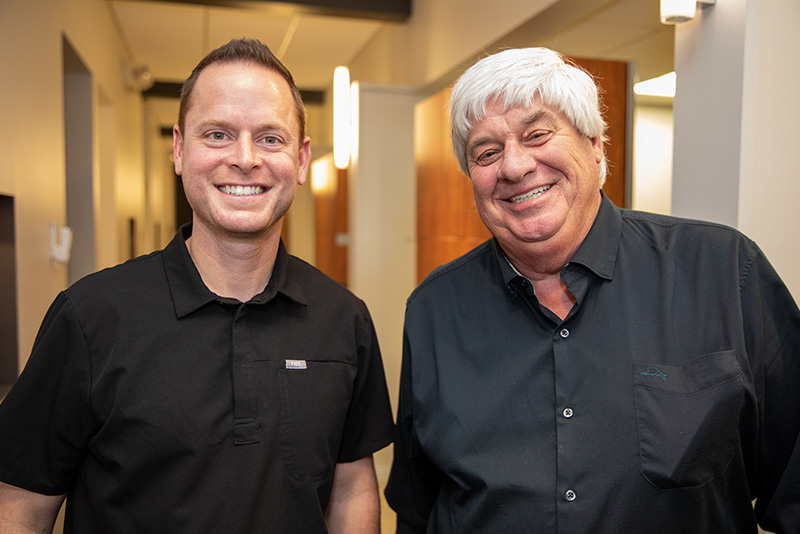Root Canals in Hilliard, Ohio
Restoring Strength With
Gentle Root Canals
Pain or sensitivity in a tooth can signal a deeper issue. If you have discomfort that lingers or gets worse with chewing or changes in temperature, you may need a root canal. At Blank Dental, we offer calm, confident care for patients needing root canals in Hilliard, Ohio.
Root canal therapy addresses infection or inflammation inside the tooth. This area—the pulp—is where nerves and blood vessels live. When the pulp becomes infected due to decay, injury, or cracks, it cannot heal on its own. Without treatment, the infection may spread, the tooth structure may weaken, and pain is likely to increase.
Our dental team takes a careful, focused approach to each root canal. We use proven methods to clean and seal the inner portion of the affected tooth, then protect the structure with a crown when needed. The result is relief from discomfort and a stronger, more stable tooth.


What Is a Root Canal?
A root canal is a dental procedure used to treat infection in the inner chamber of a tooth. The canal refers to the pathway through the tooth’s root, where the pulp sits. When that tissue becomes infected—whether from deep decay, trauma, or a damaged filling—root canal therapy may be the best option to preserve the tooth and prevent further issues.
The process involves several steps:
- Dr. James Blank numbs the area to keep you comfortable.
- A small opening is made to access the canal.
- The infected pulp is removed, and the inside of the tooth is cleaned.
- The space is filled with a material that seals it against further infection.
- In most cases, a crown is placed on top of the tooth to restore strength and appearance.
We aim to make the procedure and recovery as smooth as possible.

Signs You May Need Root Canal Treatment
Not all dental pain requires a root canal, but certain symptoms suggest a deeper problem. If you experience any of the following, you should schedule an evaluation:
- Deep, lingering tooth pain, especially with heat or cold
- Pain when chewing or applying pressure
- Swelling or tenderness near the affected tooth
- A darkened or discolored tooth
- Gum pimple or drainage near the site
Ignoring these signs allows decay and infection to spread. Prompt treatment preserves your natural tooth and prevents future damage.
What Causes Pulp Damage?
Several common issues can lead to pulp inflammation or infection:
- Deep dental decay that reaches the inner tissue
- Cracked or chipped teeth that expose the root
- Repeated dental procedures on the same tooth
- Trauma to the face that damages the inside of a tooth, even without visible cracks
- A faulty or aging crown or filling that no longer seals the tooth properly
Once the pulp becomes infected, symptoms may appear—or they may not. Even without discomfort, an infected tooth can harbor bacteria that compromise your overall oral health. A timely diagnosis ensures the best outcome.
How We Perform Root Canal Therapy at Blank Dental
We take a step-by-step approach to preserve your tooth’s strength and comfort. Here’s what to expect:
Consultation
During your visit, our Hilliard dentist examines the affected tooth and takes digital X-rays. This helps us evaluate the extent of the damage and determine if canal treatment is appropriate.
Procedure
After numbing the area, we isolate the tooth to keep it dry. Using precise tools, we remove the pulp, shape the canal, and rinse it thoroughly. We then fill the space with a permanent material and place a temporary filling.
Crown Placement
After the root canal, the tooth may feel fragile. A crown is typically placed at a later visit to protect the tooth during chewing and restore its full function.
Each step is done with care to reduce discomfort and support long-term stability.
Why Use a Crown After a Root Canal?
After the pulp is removed, the tooth no longer receives nutrients through blood flow. Over time, it may become brittle. A dental crown protects the structure during daily actions like chewing or brushing.
The crown covers the treated tooth entirely, restoring its shape and improving durability. Without a crown, the tooth risks fracture or reinfection. We match each crown to the color of your other teeth for a natural appearance.

Why Hilliard Trusts Blank Dental
We bring focused expertise and calm professionalism to every dental procedure, including root canal therapy. Our team takes the time to answer your questions and explain each step. In our Hilliard office, we use digital imaging and precise tools to deliver treatment that protects your comfort and your long-term oral health.
We understand that dental issues can be stressful. That’s why we approach root canals with care and efficiency, helping you return to your regular routine without delay.
Get in Touch

What Our Patients Say

Schedule a Root Canal Evaluation in Hilliard, Ohio
If you’re experiencing dental pain or think you may need root canal treatment, contact our team. We provide effective, straightforward care to relieve pain, clear infection, and strengthen the affected tooth.
Call Blank Dental today to set up a consultation and learn more about root canals in Hilliard, Ohio.
FAQs About Root Canals in Hilliard, Ohio
Does getting a root canal hurt?
The procedure itself is no more uncomfortable than a regular filling. Thanks to local anesthetics and modern techniques, most people report little to no pain during or after treatment. Some soreness is common once the numbness wears off, but that usually fades in a day or two.
How long does the treatment take?
A single root canal appointment takes about 60 to 90 minutes. Some cases require a second visit, especially for back teeth or teeth with complex roots.
Will I need to take antibiotics?
Your dentist may prescribe medication if there’s a significant infection. In most cases, removing the infected pulp and sealing the tooth resolves the issue without antibiotics.
What happens if I delay treatment?
Waiting can cause the decay or damage to spread. Infection can move into surrounding tissue and may even affect nearby teeth or bone. In some situations, the tooth may become unsalvageable and need removal.






